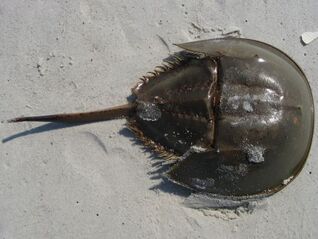 Horseshoe Crab. Photo by Anne W. York Horseshoe Crab. Photo by Anne W. York Far more than a concrete jungle, New York City boasts miles of coastline, which in late May and early June are the setting of an annual ritual that has taken place for nearly 500 million years, one of the oldest rituals to occur among animal species. During a recent stroll on Orchard Beach at Pelham Bay Park in the Bronx, I came across horseshoe crabs pulling up onshore. Intriguing looking, ancient creatures, they remind me of small tanks, able to ambulate while being fully protected by a hard carapace. Japanese legend too identifies the horseshoe crab with military symbolism. It was said that brave warriors who died honorably in battle were reborn as horseshoe crabs, with their shells like samurai helmets, forever traversing the ocean floor. Why were these creatures migrating onto the sand? Why now? Thanks to the Historical Signs Project of the NYC Department of Parks and Recreation, answering my questions -- and more -- was a nearby sign, "Horseshoe Crabs in New York City Parks, Orchard Beach - Pelham Bay Park." This is what it said about the fifth oldest species (after cyanobacteria, sponge, jellyfish, and nautilus), which has contributed greatly to medical science: Every May and June, horseshoe crabs emerge from Pelham Bay and Long Island Sound onto Orchard Beach in Pelham Bay Park. Female horseshoe crabs arrive on the beach to lay their eggs, with their male counterparts literally in tow. Males grasp onto the back of the female's shell using their specially adapted, hooked legs, sometimes two, three, or four onto one female. When they arrive on the beach, female horseshoe crabs dig a hold in the sand and lay up to 20,000 tiny olive-green eggs . The males then rush to be the first to fertilize. The process is heavily tied to the lunar cycle and its effects on the tides. The mating begins when the moon's force is strongest and the high tide allows the horseshoe crab to venture further onto the beach. As the force weakens, the water is never able to reach the eggs. Two weeks later, when the moon's force peaks again, the eggs are ready to hatch and the water sweeps the newborns into the sea. While this timing has provided protection from the sea, the eggs face other dangers. The thousands of protein-rich eggs provide a feast for hungry migrating birds, which can eat enough to double or even triple their body weight before moving on. Some birds are believed to time their migration to coincide with this mating ritual and its resulting source of nutrition. The horseshoe crab...has been around since before he dinosaurs.... This prehistoric creature may resemble a crab, but is actually more closely related to the spider and scorpion. While the horseshoe crab has a tough exterior that has helped its survival, it is one of the most harmless creatures on the seashore. Its high tolerance for pollutants has also allowed the horseshoe crab to thrive where other species have failed. When not swarming on the beaches in the spring, the horseshoe crab stays mainly on the ocean floor, feeding on mollusks, worms, and seaweed. In the winter, it burrows into the ocean sediment. While the lifespan of a horseshoe crabs in the wild is not clear, they have been known to live up to 15 years in aquariums. This "living fossil" plays an important role in modern medical science. Its blood contains Limulus Amebocyte Lysate (LAL), which is used by scientists for the detection of bacterial toxins. Tests using LAL are required by the Federal Drug Administration for medications and vaccines. Blood from the horseshoe crab is also used to make a variety of products, from fertilizers and conch bait to hairspray and contact lenses. These uses have led to the overharvesting of the horseshoe crab and a decline of its population in the Atlantic. However, the ancient horseshoe crab can still be seen crawling onto the shores of the Bronx, at Orchard Beach, every year.
0 Comments
Leave a Reply. |
About this Blog
Hi! I'm Nancy Kopans, founder of Urban Edge Forest Therapy. Join me on an adventure to discover creative ways to connect with nature in your daily life, ways that are inspired by urban surroundings that can reveal unexpected beauty, with the potential to ignite a sense of wonder. Archives
April 2023
Categories
All
|

 RSS Feed
RSS Feed